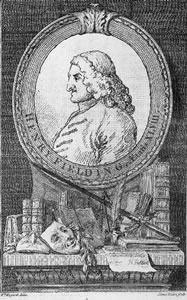Henry Fielding
Novelist & lawyer
1707-1754

Lodges in Twickenham
Across the lane at the top of Pope's garden was Hart Furlong, a sub-division of Twickenham's the South Field. Ann Adams, as the owner of a part of Pope's garden, also owned 'five half acres of Customary land' here. There was a cottage on the land and in the winter of 1747/8 Mrs Adams let it to the novelist, Henry Fielding.
Fielding had met Pope, at Prior Park, Ralph Allen's house at Bath. In 1742/3 Allen was supplying Pope with stone from his nearby quarries, to build the pair of little pavilions at each side of his riverside garden; probably his last work of building at his villa.
Fielding had other connections with Twickenham residents: he was a second cousin of Lady Mary Wortley Montagu. He was also distantly related to the 5th Earl of Denbigh, another sometime resident, whose widow returned to live in Twickenham until her death in 1769.
Fielding probably came to Twickenham to have somewhere out of the way for his second wife to give birth. This was Mary Daniel, already in the sixth month of her pregnancy when the marriage took place, on 27 November 1747. William, their son was haptised at St Mary's, Twickenham on 25 February 1748. Fielding contemplated settling in Twickenham; in a letter to James Harris dated 18 Nov 1749 he said: '. . .I having laid out all my money at present in purchasing a little Estate at Twickenham... ~, but there is no record of such a purchase. It may have been Ann Adams' property that Fielding wished to buy, but this cannot be proved.
Proof of Fielding's connection with Ann Adams rests upon entries in the Poor Rate Books for 1748. In addition to 4/- for the house she was living in, Mrs Adams or Counsellor Fielding were due to pay 10/- for a garden and house, though the money was not actually collected. Fielding, making only a short stay, had probably moved off before the rate could be claimed from him. He was a barrister and was, in 1748 made a Principal Justice of the Peace for Middlesex, and in May 1749 Chairman of Quarter Sessions at Westminster. The description 'Counsellor' was applied to barristers then.
Mistaken address
Horace Walpole confirms where Fielding stayed, on page 25 of his manuscript Book of Materials written in about 1760: 'Mr Wynde shot himself Oct 29 1 759 in the House in the back lane behind Popes; Fielding formerly liv'ed there.' This is a social and topographical description of some precision, and it conflicts with the accepted record. It has always been stated that Fielding actually lodged somewhere else in Twickenham, but this belief appears to derive from a statement of Daniel Lysons in The Environs of London. Lysons says, on page 598: 'Fielding, the celebrated novelist and dramatic writer, rented at this time a house in the Back-lane Twickenham' having obtained the information from the Earl of Orford (Horace Walpole). This turns Walpole's topographical description, mistakenly, into an address.
Lysons took Walpole to mean Back Lane (now Holly Road), behind Heath Lane (now Heath Road), so initiating an incorrect tradition. At some point the story was embellished and an actual house was identified. There is a photograph of a picture of this timber-boarded house in Twickenham Library, dated 5 March 1870, initialled JA and titled 'Henry Fielding's Cottage", and an added note states it was pulled down 1880-81.
Further reading:
Martin C Battestin, Henry Fielding, a Life, Routledge, 1989
Anthony Beckles Willson, Mr Pope & Others at Cross Deep in the 18th Century, 1996




